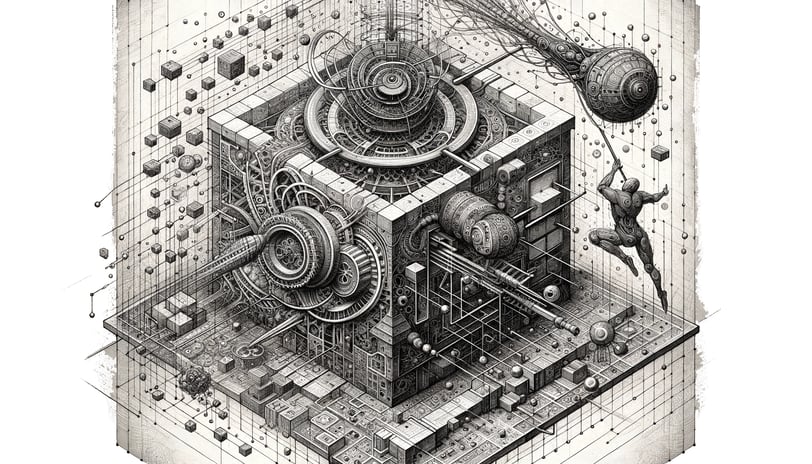Addressing RAG's Retrieval Challenges: The Impact of Re-Ranking on AI Accuracy
#KNOWLEDGE
Algopoetica
6 min read


Addressing RAG's Retrieval Challenges: The Impact of Re-Ranking on AI Accuracy
Retrieval Augmented Generation (RAG) stands as a beacon of advancement in the realm of complex AI systems, promising to elevate the capabilities of machine learning models by integrating the retrieval of external information. At its core, RAG blends the generative power of models like GPT (Generative Pre-trained Transformer) with the retrieval efficiency of databases, aiming to enhance the depth and accuracy of AI responses. However, in practice, this harmonious integration often encounters a stumbling block: the retrieval mechanism of RAG doesn't always work as seamlessly as anticipated. Despite its theoretical elegance, simple RAG implementations frequently struggle to fetch the necessary or most relevant information, leading to suboptimal outcomes.
Understanding RAG's Core Challenges
The essence of RAG's challenges can be distilled into two primary aspects: recall and context window limitations. Recall, in the context of RAG, refers to the system's ability to fetch all relevant information from its database. Ideal recall would mean retrieving every piece of pertinent data, but this is rarely achievable in practice. The reason lies in the intrinsic limitations of vector search engines used in RAG. These engines, while efficient, often lose critical nuances of information during the compression of text into vectors. This loss can lead to the exclusion of relevant data from the retrieval process.
Furthermore, RAG systems grapple with the constraints of context windows – the maximum span of text that models can consider at any given time. Large language models like GPT have predefined limits on the number of tokens they can process, which restricts the amount of information they can consider from the retrieved data. This limitation is crucial because even if a RAG system retrieves a wealth of information, it might only be able to utilize a fraction of it, potentially overlooking valuable insights nestled in the omitted data. The delicate balance between maximizing recall and managing the constraints of context windows is thus a fundamental challenge in optimizing RAG's effectiveness.
The Role of Re-Ranking in Enhancing RAG
Re-ranking emerges as the knight in shining armor for Retrieval Augmented Generation (RAG), addressing its retrieval woes with an innovative approach. This powerful solution optimizes the retrieval process by refining the selection of documents fetched by RAG. Re-rankers operate by analyzing the query and each retrieved document pair, assigning a relevance score based on the compatibility and context of the information. This process effectively reshuffles the retrieved data, prioritizing the most pertinent documents. The result is a significant boost in the quality of information fed into the generative model, enhancing the overall accuracy and relevance of the AI's output.
Comparing Rerankers and Bi-Encoders
The landscape of information retrieval in AI is dominated by two pivotal entities: rerankers and bi-encoders. While both play crucial roles, they differ fundamentally in their operation and outcomes. Rerankers, despite their slower processing time, shine in accuracy. They delve deeper into the context, considering the nuances of both the query and individual documents to produce highly relevant rankings. Bi-encoders, on the other hand, prioritize speed by pre-computing vector representations of documents. However, this approach often leads to a loss of contextual detail, putting rerankers ahead in the race for precision and effectiveness in complex retrieval tasks.
Implementing Two-Stage Retrieval with Re-Ranking
Two-stage retrieval systems in AI, specifically those employing re-ranking, have become increasingly crucial for enhancing the efficacy and accuracy of Retrieval Augmented Generation (RAG). These systems tackle the inherent limitations of simple RAG, which often struggles with effective information retrieval.
Core Mechanism
The primary stage in these systems involves the use of a retriever or an embedding model to quickly sift through a vast dataset and extract a relevant subset of documents. This process relies on vector search, where text is transformed into vectors and their proximity to a query vector is evaluated using metrics like cosine similarity. However, this method can lead to information loss due to the compression of text meaning into single vectors.
Re-Ranking's Role
To address this, the second stage employs a re-ranking model, also known as a cross-encoder. This model takes a query and document pair and outputs a similarity score. The re-ranker’s advantage lies in its ability to process raw information directly within a large transformer, thereby reducing information loss and analyzing the document's relevance to the specific query.
Implementation Steps
Data Preparation: Gather and format the data for retrieval. This involves selecting relevant chunks of text and additional metadata.
Embed and Index: Use an embedding model to convert text into vectors and store them in a vector database (like Pinecone).
Retrieval Without Reranking: Initially, retrieve documents using only the embedding model to understand baseline performance.
Reranking Integration: Incorporate a re-ranker (like Cohere's rerank endpoint) to reorder the retrieved documents based on relevance to the query.
Optimizing Retrieval: Adjust the number of documents retrieved and passed to the re-ranker to balance between retrieval recall and LLM recall.
Technical Considerations
Balancing Recall and Context Window: It's crucial to find a balance between retrieval recall (number of relevant documents retrieved) and the context window limitations of LLMs.
Avoiding Context Stuffing: Overloading the LLM's context window with too much information can degrade its recall performance.
Re-ranker's Accuracy vs. Speed: Despite being slower, re-rankers offer more accuracy than bi-encoders due to their ability to process raw information and contextual relevance.
Implementing a two-stage retrieval system with re-ranking can significantly enhance the precision and effectiveness of RAG systems, making them more suitable for complex AI applications.
Hypothetical Scenarios: The Impact of Re-Ranking on RAG's Effectiveness
Creating hypothetical scenarios helps demonstrate the effectiveness of re-ranking in improving RAG systems. By contrasting before-and-after scenarios, we can highlight how re-ranking theoretically addresses and improves information retrieval processes.
Scenario 1: Healthcare Information Retrieval
Before Re-Ranking: A RAG system is used to retrieve medical research for diagnostic assistance. It returns relevant documents, but key information is ranked lower due to vector search limitations, affecting the diagnosis quality.
After Re-Ranking: The same query, when passed through a re-ranking process, prioritizes the most relevant and accurate medical information, significantly improving diagnostic recommendations.
Scenario 2: Financial Market Analysis
Before Re-Ranking: A RAG system analyzes market trends for investment insights. It retrieves a broad range of documents, but fails to prioritize the most pertinent market analyses, leading to suboptimal investment advice.
After Re-Ranking: Re-ranking reorders the documents to highlight critical market insights, providing more accurate and actionable investment advice.
Scenario 3: Legal Case Precedents
Before Re-Ranking: A RAG system used by legal professionals retrieves numerous case laws but struggles to highlight the most relevant precedents, affecting case strategy formulation.
After Re-Ranking: The re-ranking process efficiently filters and prioritizes case laws directly related to the query, enabling more effective legal strategies.
In each scenario, re-ranking transforms the RAG system from a broad information retriever to a precision-focused tool, significantly enhancing its usefulness in complex decision-making processes.
Challenges and Considerations in Implementing Re-Ranking
Implementing re-ranking in Retrieval Augmented Generation (RAG) systems involves navigating a balance between retrieval speed and accuracy. This balance is crucial as re-ranking models, while offering higher accuracy, also introduce computational complexity, affecting the retrieval speed.
Technical Challenges
Computational Complexity: Models with more parameters or model ensembles used in re-ranking stages tend to have higher computational demands. This complexity can be problematic for text retrieval where retrieval speed is crucial.
Balancing Speed and Accuracy: The challenge lies in using these high-performance models in a way that improves accuracy while minimizing retrieval time. For instance, applying these models to a limited set of highly similar documents can enhance accuracy without significantly impacting the retrieval speed.
Implementation Considerations
Strategic Use of Models: Careful selection and strategic use of models in re-ranking stages can mitigate the speed-accuracy trade-off. This might involve selecting models based on their performance on specific tasks or using them only for particularly challenging retrieval scenarios.
Optimization Techniques: Employing optimization techniques and efficient algorithms can help manage the computational load, making re-ranking more feasible in real-time applications.
Resource Allocation: It’s crucial to allocate computational resources wisely, prioritizing accuracy in scenarios where it’s most needed while maintaining reasonable retrieval speeds.
Conclusion
Re-ranking stands out as a vital tool in addressing the retrieval challenges in RAG systems. Its implementation, while challenging due to the inherent trade-offs between speed and accuracy, offers a pathway to significantly enhance the accuracy and efficacy of AI systems. By carefully considering the technical aspects and strategically implementing re-ranking, we can optimize RAG systems for better performance, paving the way for more efficient and effective AI solutions.
As AI learns to reason, will it redefine our understanding of logic and emotion?
Copyright © 2023 Algopoetica






